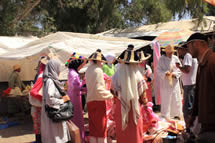 A mere nine miles and 30 minute ferry ride from Spain, Tangier, lies on the North African coast at the western entrance to the Strait of Gibraltar, where the Mediterranean mysteriously encounters the Atlantic Ocean. The historical presence of many civilisations starting from the 5th century provides the city of Tangier with a rich and intriguing past, the effects of which linger into the present.
A mere nine miles and 30 minute ferry ride from Spain, Tangier, lies on the North African coast at the western entrance to the Strait of Gibraltar, where the Mediterranean mysteriously encounters the Atlantic Ocean. The historical presence of many civilisations starting from the 5th century provides the city of Tangier with a rich and intriguing past, the effects of which linger into the present.  From 1932 until its incorporation into Morocco in 1956, Tangier was considered an international city, under the control of a committee of 30 nations, and consequently a destination for many European and American diplomats, spies, writers and business. With its souks such as the Petit and Gran Socco Market Square, traditional cuisine, stunning beaches, and historical and cultural attractions such as the Mendoubia Gardens, Caves of Hercules, and Museum of Moroccan Art, Tangier shows the face of Morocco’s most international city.
From 1932 until its incorporation into Morocco in 1956, Tangier was considered an international city, under the control of a committee of 30 nations, and consequently a destination for many European and American diplomats, spies, writers and business. With its souks such as the Petit and Gran Socco Market Square, traditional cuisine, stunning beaches, and historical and cultural attractions such as the Mendoubia Gardens, Caves of Hercules, and Museum of Moroccan Art, Tangier shows the face of Morocco’s most international city.
 Chefchaouen sits nestled high in the Rif Mountains, just inland from Tangier and Tetouan. Founded in 1471 by Moorish exiles from Spain to fight the Portuguese invasions of the north, the name of Chefchaouen refers to the shape of the mountain tops above the town which resemble the two horns of a goat. A popular destination, Chefchaouen is famous for its vivid blue rinsed houses and buildings. Winding lanes and narrow alleys are home to numerous souks offering cuisine and artisan works, such as woollen items, intricate embroidery, and goats cheese; all native to the North and not found anywhere else in Morocco.
Chefchaouen sits nestled high in the Rif Mountains, just inland from Tangier and Tetouan. Founded in 1471 by Moorish exiles from Spain to fight the Portuguese invasions of the north, the name of Chefchaouen refers to the shape of the mountain tops above the town which resemble the two horns of a goat. A popular destination, Chefchaouen is famous for its vivid blue rinsed houses and buildings. Winding lanes and narrow alleys are home to numerous souks offering cuisine and artisan works, such as woollen items, intricate embroidery, and goats cheese; all native to the North and not found anywhere else in Morocco.